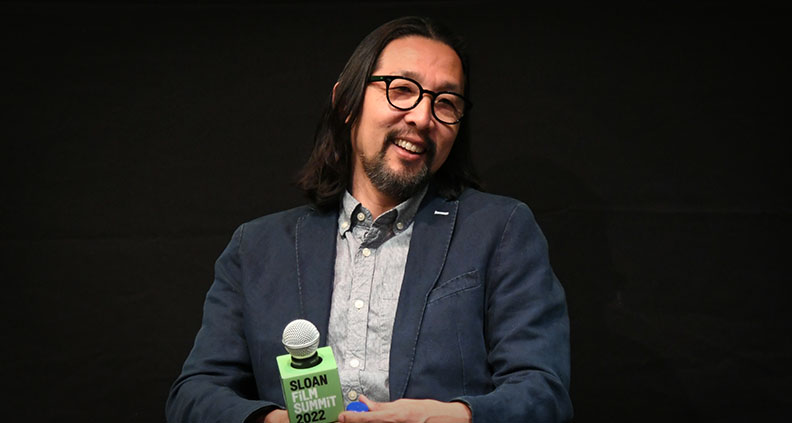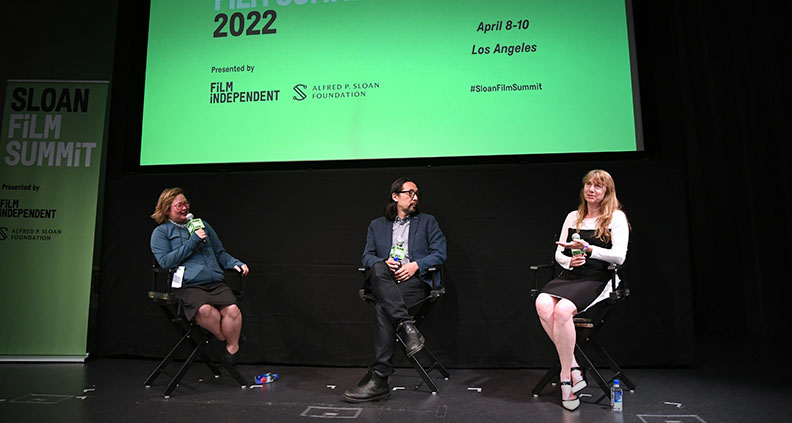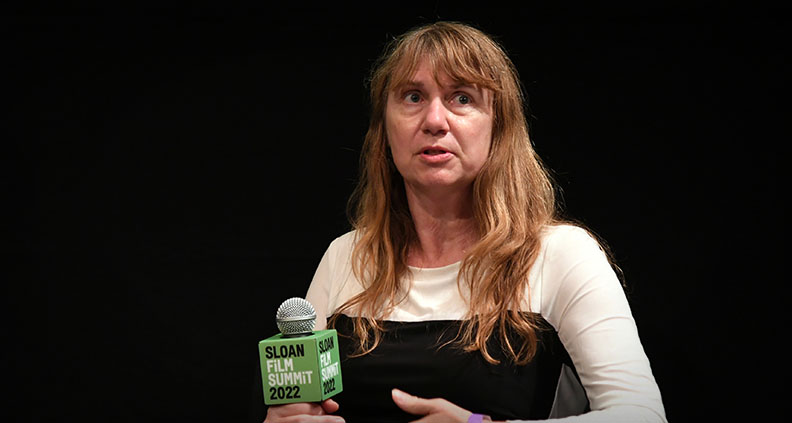Recap and Full Panel: Kogonada and A.I. Expert Maja Matarić Talk ‘After Yang’
After Yang is not your typical robot movie. The film’s titular A.I. is neither muscle-bound super-soldier sent back from the future to protect Eddie Furlong nor baritone-voiced alien capable of transforming into a truck, tank or (improbably) dinosaur. Yang—the “synthetic sibling” purchased by future-dwelling couple Jake and Kyra (Colin Farrell, Jodie Turner-Smith) to help connect their adopted daughter Mika (Malea Emma Tjandrawidjaja) back to her Chinese roots through “fun facts” and Zen companionship—doesn’t even long to be human, perhaps the hoariest and most suspect of all android-based clichés.
The critically-acclaimed film was awarded the Alfred P. Sloan Feature Film Prize at the 2022 Sundance Film Festival, where it premiered, and is the recipient of a $50,000 distribution grant through Film Independent.
“One of my interests was not so much about Yang, but about humans and their emotional attachment to technology,” said the filmmaker Kogonada of his sophomore feature, now out from juggernaut indie studio A24. It was April 8 in Los Angeles, during a post-screening Q&A with the director alongside USC roboticist and artificial intelligence researcher Maja Matarić.
The audience? An invitation-only selection of the brightest creative minds in both science and cinema—gathered for Opening Night of the triennial Sloan Film Summit at the Tateuchi Democracy Forum in Little Tokyo. Moderating the Friday night conversation was journalist and film producer Jennifer 8. Lee.
But while Kogonada’s Yang (an ethereal Justin H. Min) remains at peace with his relative level of humanness, he does wonder if he is, in fact, Asian. “Being an Asian robot doesn’t actually make you Asian—it’s a construct,” said Kogonada, touching upon just one of the many ideas that attracted the Korean-American filmmaker to Alexander Weinstein’s 2018 short story “Saying Goodbye to Yang,” about the breakdown of a mechanized domestic servant, whose loss is at first regarded on par with that of a faulty kitchen appliance, before his guardians’ overwhelming grief forces them to revaluate Yang’s being and place in their family.

Asked how close we are to IRL beings with Yang’s level of sophistication, Matarić laughed. “Not close at all!” she said. “We can create things that look realistic if you don’t dig into a deep interaction with them.” Matarić was also careful to draw a distinction between artificial intelligence and artificial presence, the latter of which better describes contemporary observant-and-reactive technologies like smarthome devices and iPhones.
She also reiterated the idea of the “uncanny valley,” saying that humans generally prefer less realistic and/or humanoid robots, whose simplistic or recognizably artificial design more closely reflects their limited scope of capabilities.

Drawing a distinction between the trauma caused by Yang’s failure and that of a broken vacuum cleaner, Kogonada observed, “There’s something peculiar about human beings experiencing different kinds of loss.” Matarić jumped in, saying that the gap between the two might not be as vast as one would think. Taking note of Roomba vacuum cleaners in particular, she said, “People have been buying these for a long time, and they get really attached to their Roombas.”
And as in Yang, when a Roomba product fails and the manufacturer offers to replace it, consumers will frequently reject the idea. They want their Roomba that they’re emotionally attached to. So “this is already happening with precisely vacuum cleaners, so you can imagine how we [humans] would react to something humanoid,” said Matarić.
While pop culture is replete with examples of terrifying A.I. takeovers, Matarić isn’t so worried. “There are quite a lot of therapeutic, well-intentioned systems being developed,” particularly in working with autistic children and Alzheimer’s patients, she says. “People also worry about privacy, which I laugh at,” she added, “We’ve already given privacy up in every possible way.” The thing she is worried about, however, is knowing and understanding what special interests may be involved with the programming, manufacturing and distribution of such devices.
Kogonada also sees After Yang representative of the the “otherness” he himself feels living in the West as part of the Asian diaspora. Yang’s express purpose in the film is to pass along an awareness and appreciation of his and Mika’s shared “Asianness—but who programmed him and decided what “Asian” is, exactly? It’s an insecurity Kogonada relates to his own experience. “I think we [Asians] are constantly negotiating that—either feeling too Asian or not Asian enough.”

He added, “One of the things about otherness that I was very interested [in] was thinking about the other beings in our world”—it was not clear here if he meant the fictional world of After Yang, our reality or perhaps both—”is what brings dignity to that other group.”
“There are already examples of robots being bullied,” observed Matarić. But also instances of robots in distress being rescued or otherwise assisted in some way by empathetic human bystanders. “These machines that are ‘other’ can bring out the best in us—and the worst.”
The 2022 Sloan Film Summit is happening April 8-10 in Los Angeles. Stay tuned to sloanfilmsummit.org for videos, blog recaps and more. Follow our coverage on Film Indepenent’s Twitter, Facebook and Instagram.
(Header: The Alfred P. Sloan Foundation’s Doron Weber, Jennifer 8. Lee, Maja Matarić and Kogonada)